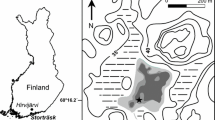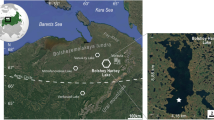Abstract
Cladoceran microfossil remains were analysed from a sediment core taken from a lake basin at Kråkenes, western Norway. The sequence included immediate post-glacial conditions (ca. 12,300 14C BP), the Allerod, Younger Dryas, and early Holocene to approximately 8,500 14C BP. The interpretation of changes in the cladoceran assemblages is based on the known ecology of the taxa, the documented environmental history of the study sequence, the variations in the organic content of the sediment, the radiocarbon dates, and the results of analyses of other biotic groups, including diatoms, macrophytes, and chironomids. In addition, a quantitative reconstruction of changes in air temperature is presented for the study period. This reconstruction is based on transfer functions developed from a separate Swiss surface-sediment cladoceran data set.
The cladoceran assemblages throughout the sequence are dominated by littoral chydorid taxa. Bosmina, Daphnia, and Simocephalus represent the open-water component of the zooplankton. Chydorus piger and Daphnia were the only immediate post-glacial pioneer taxa. A rapid proliferation of the open-water and littoral cladoceran taxa began with the onset of the Allerod and persisted for approximately 1,000 yrs. At the start of the Younger Dryas a local glacier formed and drained into the lake, causing a sudden decline in chydorid diversity, with only Chydorus sphaericus and Acroperus harpae persisting throughout this period. Chydorid diversity started to recover in the upper Younger Dryas and continued in the early Holocene. Progressive acidification and oligotrophication are also discernible from the cladoceran assemblages present in the Holocene.
The reconstructed mean summer air temperature was from 8-21 °C, with prediction errors of 1.8-2.5 °C. The Allerod was only slightly warmer than the Younger Dryas period, but a progressive increase in temperature is apparent during the early Holocene. In conclusion, the results of this study provide a further demonstration of the value of cladocera as indicators of a variety of palaeoenvironmental parameters, including temperature.
Similar content being viewed by others
References
Beales, P. W., 1976. Palaeolimnological studies of a Shropshire Mere. Ph.D. thesis, University of Cambridge, 151 pages, 4 appendices.
Birks, H. H., 1994. Late-glacial vegetational ecotones and climatic patterns in western Norway. Veg. Hist. Archaeobot. 3: 107–119.
Birks, H. H., 2000. Aquatic macrophyte vegetation development in Kråkenes Lake, western Norway during the late-glacial and early-Holocene. J. Paleolim. 23: 7–19.
Birks, H. H., R. W. Battarbee, D. J. Beerling, H. J. B. Birks, S. J. Brooks, C. A. Duigan, S. Gulliksen, H. Haflidason, F. Hauge, V. J. Jones, B. Jonsgard, M. Kårevik, E. Larsen, G. Lemdahl, R. Løvlie, J. Mangerud, S. M. Peglar, G. Possnert, J. P. Smol, J. O. Solem, I. W. Solhøy, T. Solhøy, E. Sønstegaard & H. E. Wright, 1996a. The Kråkenes Late-glacial Palaeoenvironmental Project. J. Paleolim. 15: 281–286.
Birks, H. H., R. W. Battarbee & H. J. B. Birks, 2000. The development of the aquatic ecosystem of Kråkenes Lake, western Norway, during the late-glacial and early-Holocene — a synthesis. J. Paleolim. 23: 91–114.
Birks, H. H., S. Gulliksen, H. Haflidason, J. Mangerud & G. Possnert, 1996b. New radiocarbon dates for the Vedde Ash and the Saksunarvatn Ash from western Norway. Quat. Res. 45: 119–127.
Birks, H. H., M. C. Whiteside, D. Stark & R. C. Bright, 1976. Recent paleolimnology of three lakes in northwestern Minnesota. Quat. Res. 6: 249–272.
Birks, H. H. & H. E. Wright, 2000. Introduction to the reconstruction of the late-glacial and early-Holocene aquatic ecosystems at Kråkenes Lake, Norway. J. Paleolim. 23: 1–5.
Birks, H. J. B., 1995. Quantitative palaeoenvironmental reconstructions. In Maddy, D. & J. S. Brew (eds), Statistical Modelling of Quaternary Science Data, Technical Guide 5, Quaternary Research Association, Cambridge, pp. 161–254.
Bradshaw, E. G., V. J. Jones, H. J. B. Birks & H. H. Birks, 2000. Diatom responses to late-glacial and early-Holocene environmental changes at Kråkenes, western Norway. J. Paleolim. 23: 21–34.
Brooks, S. J., 1997. The response of Chironomidae (Insecta: Diptera) assemblages to late-glacial climatic change in Kråkenes Lake, western Norway. Quat. Proc. 5: 49–58.
Brooks, S. J. & H. J. B. Birks, 2000. Chironomid-inferred late-glacial and early-Holocene mean July air temperatures for Kråkenes Lake, western Norway. J. Paleolim. 23: 77–89.
Cotten, C. A., 1985. Cladoceran assemblages related to lake conditions in eastern Finland. Ph.D. thesis, Indiana University.
Duigan, C. A., 1992. The ecology and distribution of the littoral freshwater Chydoridae (Branchiopoda, Anomopoda) of Ireland, with taxonomic comments on some species. Hydrobiologia 241: 1–70.
Duigan, C., 1996. The environmental history of a late-glacial site at Kråkenes, western Norway, based on cladoceran microfossil assemblages: preliminary results and interpretation. Quaternary Newsletter 80: 2–9.
Duigan, C. A. & H. H. Birks, 1997. Reconstructing temperature changes from cladoceran microfossil assemblages at the lateglacial site of Kråkenes, western Norway. Würtzburger Geographische Manuskripte 41: 63–64.
Duigan, C. A. & W. L. Kovach, 1991. A study of the distribution and ecology of littoral freshwater chydorid (Crustacea, Cladocera) communities in Ireland using multivariate analyses. J. Biogeogr. 18: 267–280.
Fitzmaurice, P., 1965. Studies on the Planktonic Cladocera in Lough Corrib and in the Carna District, with particular reference to qualitative and quantitative seasonal frequency of the cladoceran fauna in Lough Corrib. M.Sc. thesis. National University of Ireland, University College Galway. 131 pp.
Frey, D. G., 1958. The late-glacial cladoceran fauna of a small lake. Arch f. Hydrobiol. 54(1/2): 209–275.
Frey, D. G., 1982. Questions concerning cosmopolitanism in Cladocera. Arch. Hydrobiol. 93: 484–502.
Frey, D. G., 1986a. Cladocera Analysis. In Berglund, B. E. (ed.), Handbook of Holocene Palaeoecology and Palaeohydrology. John Wiley & Sons Ltd.: 667–692.
Frey, D. G., 1986b. The non-cosmopolitanism of chydorid Cladocera: implications for biogeography and evolution. In Heck, K. L. & R. H. Gore (eds), Crustacean Issues, Vol. 4, Crustacean Biogeography. A.A. Balkema, Rotterdam: 237–256.
Frey, D. G., 1987. The taxonomy and biogeography of the Cladocera. Hydrobiologia 145: 5–17.
Fryer, G., 1993. The Freshwater Crustacea of Yorkshire. A faunistic and ecological survey. Yorkshire Naturalist's Union & Leeds Philosophical and Literary Society, 312 pp.
Goulden, C. E., 1964. The history of the cladoceran fauna of Esthwaite Water (England) and its limnological significance. Arch. Hydrobiol. 60: 1–52.
Grimm, E. C., 1990. TILIA and TILIA.GRAPH, PC spreadsheet and graphics software for pollen data. INQUA Working Group on Data Handling Methods Newsletter 4: 5–7.
Gulliksen, S., G. Possnert, J. Mangerud & H. H. Birks, 1994. AMS 14C dating of the Kråkenes late Weichselian sediments. Abstract PE-22, 15th International Radiocarbon Conference, Glasgow, 15–19 August 1994.
Gulliksen, S., H. H. Birks, G. Possnert & J. Mangerud, 1998. A calendar age estimate of the Younger Dryas — Holocene boundary at Kråkenes, western Norway. The Holocene 8: 249–259.
Hann, B. J., 1989. Methods in Quaternary Ecology No. 6. Cladocera. Geosci. Can. 16: 17–26.
Hann, B. J. & B. G. Warner, 1987. Late Quaternary cladocera from coastal British Columbia, Canada: A record of climatic or limnological change? Arch. Hydrobiol. 110: 161–177.
Harmsworth, R. V., 1968. The developmental history of Blelham Tarn (England) as shown by animal microfossils, with special reference to the cladocera. Ecol. Monogr. 38: 223–241.
Hofmann, W., 1978. Analysis of animal microfossils from the Groβer Segeberger See (F.R.G.). Arch. Hydrobiol. 82(1/4): 316–346.
Hofmann, W., 1984. Postglacial morphological variation in Bosmina longispina Leydig (Crustacea, Cladocera) from the Groβer Plöner See (north Germany) and its taxonomic implications. Z. zool. Syst. Evolut.-forsch. 22: 294–301.
Hofmann, W., 1986. Developmental history of the Grosser Plöner See and Schöhsee (north Germany): cladoceran analysis, with special reference to eutrophication. Arch. Hydrobiol. 110: 161–177.
Hofmann, W., 1987. Cladocera in space and time: Analysis of lake sediments. Hydrobiologia 145: 315–321.
Hrbácek, J., V. Korínek & D. G. Frey, 1978. Cladocera. In Illies, J. (ed.), Limnofauna Europea. Fischer Verlag, Stuttgart, NewYork: 189–195.
Jonsgard, B. & H. H. Birks, 1995. Late-glacial mosses and environmental reconstructions at Kråkenes, western Norway. Lindbergia 20: 64–82.
Korhola, A., 1992. The Early Holocene hydrosere in a small acid hill-top basin studied using crustacean sedimentary remains. J. Paleolim. 7: 1–22.
Larsen, E., F. Eide, O. Longva & J. Mangerud, 1984. Allerød-Younger Dryas climatic inferences from cirque glaciers and vegetational development in the Nordfjord area, western Norway. Arct. Alp. Res. 16: 127–160.
Lotter, A. F., H. J. B. Birks, W. Hofmann & A. Marchetto, 1997. Modern diatom, cladocera, chironomid, and chrysophyte cyst assemblages as quantitative indicators for the reconstruction of past environmental conditions in the Alps. I. Climate. J. Paleolim. 18: 395–420.
Mangerud, J., E. Larsen, O. Longva, E. Sønstegaard, 1979. Glacial history of western Norway 15000–10000 B.P. Boreas 8: 179–187.
Nilssen, J. P. & S. Sandøy, 1990. Recent lake acidification and cladoceran dynamics: surface sediment and core analyses from lakes in Norway, Scotland and Sweden. Phil. Trans. r. Soc., Lond. B 327: 299–309.
Patalas, K., 1990. Diversity of the zooplankton communities in Canadian lakes as a function of climate. Verh. int. Ver. Limnol. 24: 360-368.
Scourfield, D. J. & J. P. Harding, 1966. A key to the British species of freshwater Cladocera. 3rd Edition. Freshwater Biological Association, Scientific Publication No. 5, 55 pp.
Smol, J. P. & M. M. Boucherle, 1985. Postglacial changes in algal and cladoceran assemblages in Little Round lake, Ontario. Arch. Hydrobiol. 86: 25–49.
Solhøy, I. W. & T. Solhøy, 2000. The fossil oribatid mite fauna (Acari: Oribatida) in late-glacial and early-Holocene sediments in Kråkenes Lake, western Norway. J. Paleolim. 23: 35–47.
Stalsberg, M. K., 1995. Seinglasial sedimentasjon i Kråkenesvatnet, Vågsøy, Sogn og Fjordane. Cand. Scient. Thesis, University of Tromsø. (Late-glacial sedimentation in Kråkenes Lake, Vågsøy, Sogn og Fjordane).
Stansfield, J., B. Moss & K. Irvine, 1989. The loss of submerged plants with eutrophication III. Potential role or organochlorine pesticides: a palaeoecological study. Freshwat. Biol. 22: 109–132.
Synerholm, C. C., 1979. The chydorid cladocera from surface lake sediments in Minnesota and North Dakota. Arch. Hydrobiol. 86: 137–151.
ter Braak, C. J. F. & S. Juggins, 1993. Weighted averaging partial least squares regression (WA-PLS): an improved method for reconstructing environmental variables from species assemblages. Hydrobiologia 269/270: 485–502.
Tsukada, M., 1972. The history of Lake Nojiri, Japan. Trans. Connecticut Academy of Arts and Sciences 44: 339–365.
Walseng, B., 1994. Alona spp. in Norway: Distribution and Ecology. Verh. int. Ver. Limnol. 25: 2358–2359.
Walker, I. R., A. J. Levesque, L. C. Cwynar & A. F. Lotter, 1997. An expanded surface-water palaeotemperature inference model for use with fossil midges from eastern Canada. J. Paleolim. 18: 165–178.
Whiteside, M. C., 1970. Danish cladocera: modern ecology and core studies. Ecol. Monogr. 40: 79–118.
Whiteside, M. C. & M. R. Swindoll, 1988. Guidelines and limitations to cladoceran paleoecological interpretations. Palaeogeogr. Palaeoclim. Palaeoecol. 62: 405–412.
Author information
Authors and Affiliations
Rights and permissions
About this article
Cite this article
Duigan, C.A., Birks, H.H. The late-glacial and early-Holocene palaeoecology of cladoceran microfossil assemblages at Kråkenes, western Norway, with a quantitative reconstruction of temperature changes. Journal of Paleolimnology 23, 67–76 (2000). https://doi.org/10.1023/A:1008004513301
Issue Date:
DOI: https://doi.org/10.1023/A:1008004513301




